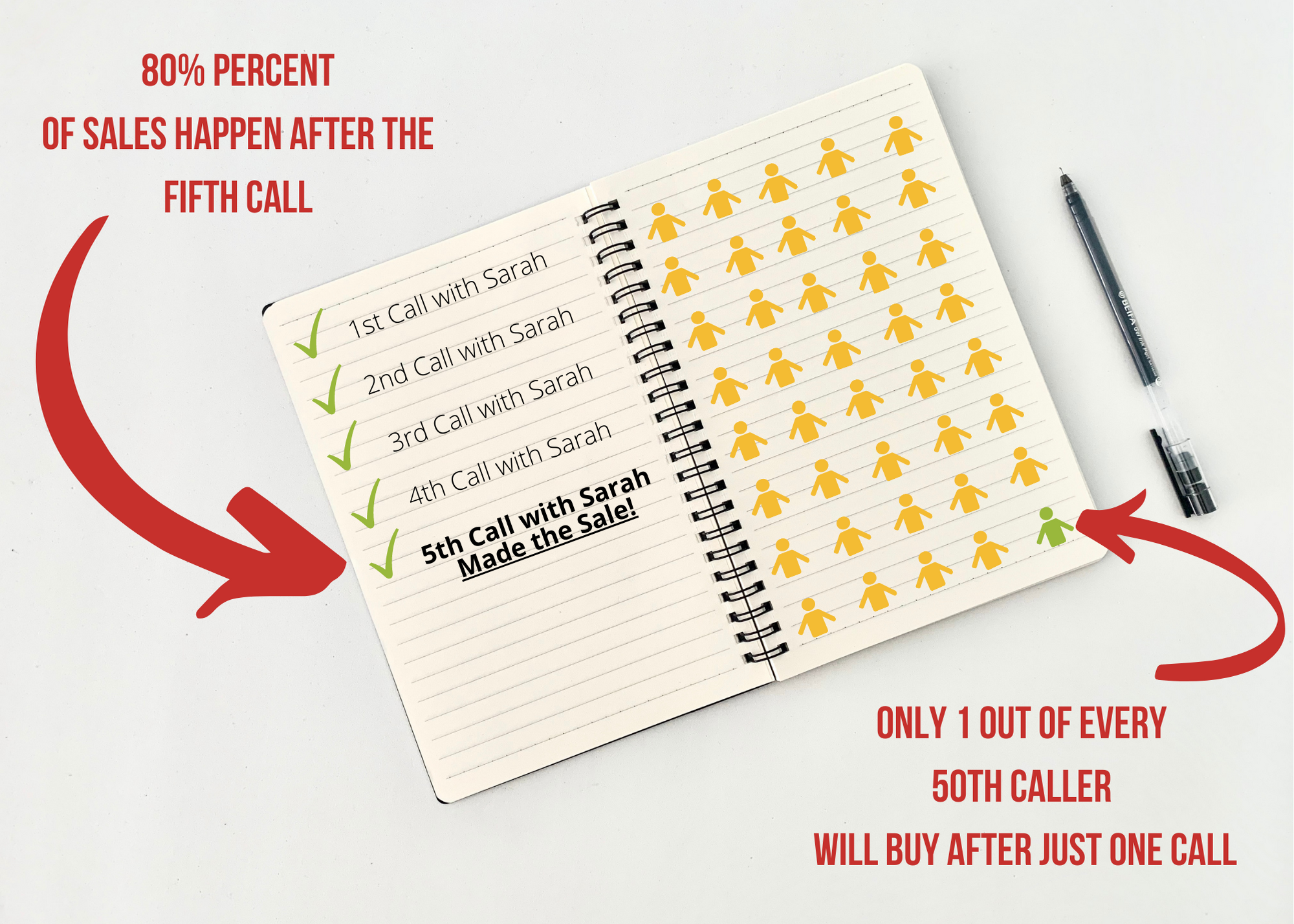
It’s all about patience and persistence! We know that slow and steady wins the race, so why shouldn’t we apply that method to follow-ups? This might be a 180 from what you thought about follow-ups, but it just makes sense!
Sales Follow Up Statistics
The statistics don’t lie! Sales follow up calls after the fifth call is where 80% of the sales are made. Therefore don’t stop contact after only four calls.
What does this statistic tell you about the first initial calls? Well, the first few calls are getting to know the caller and gaining their trust. You wouldn’t hire someone without interviewing them once, twice, three or more times. Only after the trust has been built, will your sales team be able to make the sale.
Here is another statistic to reflect on. Only 3% of the market is actively buying, 56% are not ready, and 40% will be ready to purchase in the near future. This reveals the importance of time and should encourage your sales team to continue building the B2C or B2B relationships, so when they are ready to purchase they know they can rely on your company to give them the product or service they need.
There are many more statistics like the ones above that back up the claim that follow-ups are where most of the sales opportunities are. You will learn more about the stats and will learn how to implement follow-ups in your sales process as you continue reading.
Phone or Mail Sales Follow Up
There’s no right or wrong answer on how to follow up. The salesperson will have to look at the circumstances of each prospect and make the best decision.
For instance, you might have a prospect that is ready to purchase something right away. In this circumstance you shouldn’t follow-up with an email, because there’s no way in determining how long it will take for them to respond. By the time they see your sales follow up email they could have gone to a competitor.
If time is of the essence, utilizing a phone follow-up is the best option to ensure immediate contact and reinforce the relationship that has already started to form.
If time is not an issue, an email is the best way to follow up. Emails are a good way to share what you discussed, your contact information, and any deals or discounts available. This gives the prospects something to think about until your next call or meeting. Also, studies show that people find emails less demanding than a phone call. If the salesperson isn’t careful they can overwhelm the prospect with too many phone calls in a short period of time, that will lead them to saying NO instead of maybe.
Sales Follow Up Frequency
Since it can be fairly easy to annoy the prospect with calls, you should create a follow up frequency for your sales team to follow, that is respectful of people’s time, yet frequent enough to keep your company on their radar. For instance:
- 1st call: wait 2 days to follow up
- 1st follow up: wait 4 days to follow up
- 2nd follow up: wait a week to follow up
- 3rd follow up: wait two weeks
- 4th follow up: wait a month
- 5th follow up: wait a month (from here on out call once a month)
While this is just a suggestion, you’ll want something similar for your sales team to refer to. Also, keep in mind that some prospects will be the exception to this frequency guide. A prospect might disclose how often they would allow contact and therefore the salesperson should go by that. There are other expectations that the salesperson will have to use their judgement on but otherwise following this guide will help them keep contact with the prospects orderly.
Sales Follow Up Tips
First, ask yourself if competitors use the same techniques or phrases that your sales team uses. If they do, change your strategy immediately. Your company will never stand out in prospects email or voicemail inboxes if the competitors follow-ups look like yours.
Think about your own inbox. You likely have so many emails that you quickly scan through and delete as you go, never even reading so much as the subject line. People don’t have the time to read over every email and often don’t listen to an entire voicemail before deleting it.
If, however, something stood out to them or appealed to them in some way, they would be willing to read on or listen further. All you need your sales team to do is get that second of hesitation from the prospect to make them consider not deleting your message.
Here are two helpful tools to look into as you improve your follow-ups:
- The Power Dialer is a crm & dialing software that allows you to set follow ups and keep track of everything-who you’ve contacted, when and more.
- Headline Analyzer offers a tool that allows you to analyze the effectiveness of subject lines and offers assistance in perfecting them.
Keep Email Follow-ups Short and Straight to the Point
For phone calls and emails you’ll want to get to the point fast! Majority of the time the prospect will not wait to hear you ramble. Their time is precious and you should treat it as such. Here is a useful tool that will help you express only the most necessary information to keep the recipient engaged. By keeping your follow-ups short and to the point your salespeople will receive more positive responses than they would with a long follow-up.
Provide Value in Follow-up Calls
Remember to add value to the prospects’ life by giving them useful information, offering assistance, and/or answering questions and concerns that they might have. Your sales team must offer something worthwhile every time they contact a prospect in order to earn their response.
Another approach to a follow up is reminding them of the struggle or disadvantage of not having your product. Be cautious to not sound rude but rather try to empathize with them. This gives the salesperson the advantage to explain how they’d like to solve the problem for them since they empathize with their needs.
Providing value should be fundamental to your whole strategy. If you’re unsure how to do it, check out our guide on building a great sales strategy.
Use Data to Back Up Your Claims in Follow-up Calls
If you get the chance, include data/statistics in your follow ups. It’s easy to ignore opinions but not as easy to overlook tested and proven data. The recipient of the follow up will have to consider the facts, especially if they are shocking.
One of the best ways to draw their attention is by putting a shocking fact about your product or service as the subject line. For example “91% of email users have unsubscribed from a company email they previously opted-in to.” Then the company can proceed to tell them how to avoid this problem in the email.
The key is to use data to grab their attention, so they are wanting to know more. Once your sales team learns how to use data to their advantage, they will begin seeing more feedback.
Be Clear With the Next Steps When Following Up
Provide clear next steps. This will vary per prospect but your goal is to get them to move further down the sales pipeline. An example could be “So glad we had our first meeting! Attached in this email is a survey, if you could take a minute of your time and fill out the survey of how you think the call went, it would be greatly appreciated. Also, I would like to set up another meeting, please let me know what time(s) you’re available within the next two weeks, so we can discuss the discounts we offer.”
If you still find it hard to craft follow-up messages on your own, have a look at the following scripts and templates. They are generic but will help you start with a foundation. Customize them to suit your company’s objectives and make them work for your sales people.
Sales Follow Up Call Script
Now we will give different examples for different cases of follow ups. These are just generic examples to get your scripts started:
Follow Up After the First Sales Call
<[Name], Thank you for taking the time to talk last time. I’d like to check whether you want us to continue discussing [Product/Solution, etc.]? Maybe we can talk about [Next step], so you’re not in the dark about what follows? >>
This is a casual follow-up sales call script to use with a prospect after the first initial call. It’s not overbearing, or forceful but it is helpful and informative.
Follow Up on Voicemail
<< Hello [Name], it is [Name] from [Company]. It seems like you are currently busy. I totally understand how it is. Please, call me back at a more convenient time so we can discuss [Product/Solution, etc.] Looking forward to hearing from you. >>
Again, this approach is not overbearing. Keep that in mind when writing these scripts. The prospect doesn’t want to hear the entire sales pitch. Briefly say what you want to discuss or what was already discussed and let them know you are looking forward to talking again when it’s convenient for them.
Follow Up After No Answer
<< Hello [Name], it is [Name] from [Company]. I am sad that we haven’t talked recently. Still, I don’t want to bother you, so if you’re not still interested in [Product/ Solution, etc.], this will be a goodbye. Call me back if you reconsider! Best wishes! >>
Although you never want to see a prospect go, you must leave the ball in their court AND leave it on good terms. Reassure them that you will be glad for their service if they ever decide to reconsider.
Sales Follow Up Email Template
Now we will give different examples for different cases when it comes to follow-up emails. We have scripts for each outcome possible and we will explain instances in which you will use theses scripts:
Follow Up After the First Sales Call
Subject: Are You Ready to Talk About the Next Steps?
Hello [Name],
I’d like to thank you for taking the time to talk and check whether you want us to continue discussing [Product/Solution, etc.].
Are you ready to [Next step]?
Looking forward to your answer.
Best wishes,
[Sign off]
The key here is simplicity! The prospect doesn’t want to read a long drawn out email, they just want the bare minimum. By quickly stating the product or service, giving clear next steps, and giving them time to consider, they will be much more willing to respond when they have had time to consider it.
This approach is best after the first sales call because it doesn’t jump right into the selling process. You have to ease the prospect into the sales pipeline.
Follow Up After Leaving a Voicemail
Subject: Let’s Find a Convenient Time to Talk
Hello [Name],
I tried to contact you but I assume you are currently busy. I totally understand how it is.
When it is more convenient for you, please call me back at [Number] or just write me an email to let me know when I should give you another call.
Looking forward to hearing from you.
[Sign off]
How long do you think someone will listen to a voicemail for? The answer is…not very long at all. Therefore, let them know how they can contact you and let them know you will be available whenever it’s convenient for them.
Are you starting to see the trend? Make is simple. Make it convenient. Give them time.
I know it seems opposed to traditional selling tactics, BUT if you just refer to the follow-up frequency we created above, you are sure to get more sales.
Follow Up After No Answer
Subject: Is This It? I’m Still Hoping to Connect.
Hello [Name],
I am sad that we haven’t talked recently. Still, I don’t want to bother you, so if you’re not still interested in [Product/ Solution, etc.], this will be a goodbye.
Please let me know if you want to stay in touch.
I don’t mean to bother you but would appreciate knowing your decision.
Thank you a lot!
Best wishes,
[Sign off]
If the prospect has not responded, ask them a final time if they aren’t interested in the product and ask them their decision. They might respond with useful information like “I appreciate your call, however, I’m just not ready to buy” or “Thank you for the call, however, I can’t afford the product/service at the moment” This will help the salesperson makes notes of how to continue contact and when to continue contact on the prospects. Lastly, always leave the prospect feeling like their needs are important, and let them know that their needs will be met by your sales team and the company.
Continue reading how to qualify your leads and questions to ask!
Works Cited
IRC Sales Solutions. 2021. 35 Sales Follow Up Statistics For 2021 [Infographic] — IRC Sales Solutions. [online] Available at: <https://ircsalessolutions.com/insights/sales-follow-up-statistics> [Accessed 15 January 2021].
Efti, S., 2021. Master The Sales Follow-Up With This Proven Formula (Tells You Exactly When And How To Follow-Up For Maximum Results). [online] The Close Sales Blog. Available at: <https://blog.close.com/follow-up/> [Accessed 15 January 2021].
Marrs, M., 2021. The 9 Best Email Subject Line Styles To Increase Your Open Rates. [online] Wordstream.com. Available at: <https://www.wordstream.com/blog/ws/2014/03/31/email-subject-lines> [Accessed 15 January 2021].
Friedman, E., Haynam, J., Johnson, J., Stewart, K. and Tyrrell-Morin, C., 2021. Sales Follow-Up Technique: 5 Ways To Improve Sales. [online] Keap.com. Available at: <https://keap.com/business-success-blog/sales/sales-process/sales-follow-up-techniques> [Accessed 19 January 2021].
Gennaro, L., 2021. 99+ Mind-Blowing Digital Marketing Statistics (2021). [online] WPForms. Available at: <https://wpforms.com/digital-marketing-statistics/> [Accessed 19 January 2021


